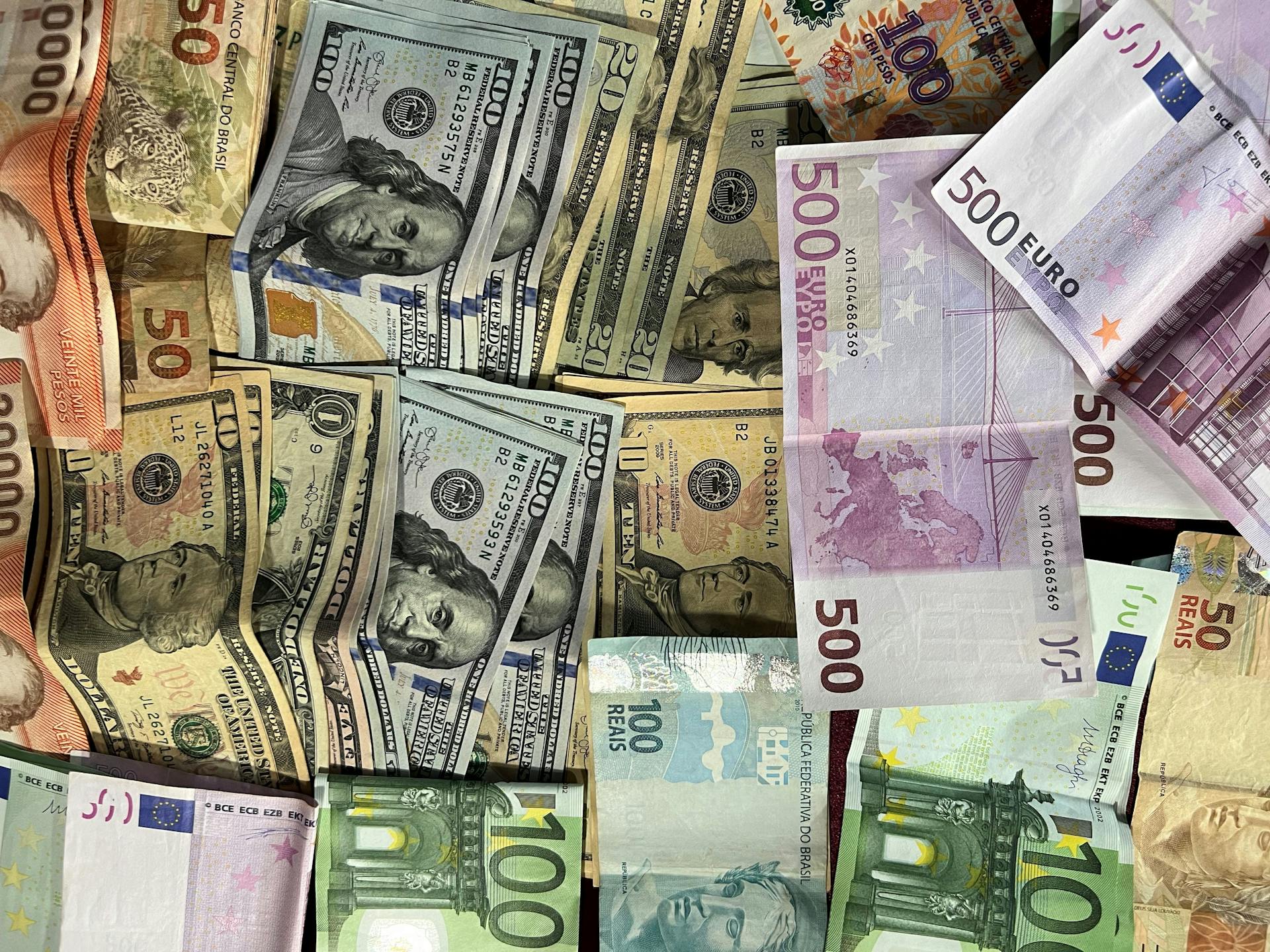
The international monetary standard is a system used by countries to manage their economies and facilitate international trade. It's based on a set of rules and guidelines that help countries manage their exchange rates and monetary policies.
The gold standard, which was widely used from the late 19th century to the mid-20th century, was one of the earliest forms of international monetary standard. Under this system, countries pegged their currencies to the value of gold.
Countries that use the gold standard were required to back their currencies with a reserve of gold, which helped to maintain the value of their currency.
Consider reading: Gold Standard Zimbabwe
A History
The history of international monetary standards is a long and complex one, but it's fascinating to explore. The gold standard, which emerged in the 1870s, was the first major international monetary standard, and it lasted until the outbreak of World War I.
The gold standard was characterized by a fixed exchange rate system, where each country pegged its currency to gold. The British pound, for example, was fixed at 4.247 pounds sterling per ounce of gold, while the US dollar was fixed at $20.67 per ounce.
Curious to learn more? Check out: Gold Standard Monetary
The gold standard was a major innovation in international finance, but it had its limitations. During the Great Depression, many countries were forced to abandon the gold standard, leading to a period of economic instability.
In the post-World War II era, a new international monetary system was established at the Bretton Woods conference in 1944. This system, which lasted until 1971, featured a dollar-based monetary system with fixed but adjustable exchange rates.
The Bretton Woods system was a major improvement over the gold standard, as it allowed countries to devalue their currencies by up to 10% against the dollar, and it introduced a system of capital controls to protect countries from capital flight.
However, the Bretton Woods system ultimately broke down in the 1970s, and the world shifted to a system of floating exchange rates. This shift marked the beginning of a new era in international monetary policy.
Here's a brief timeline of the major international monetary standards:
- 1870s: Gold standard emerges
- 1944: Bretton Woods conference establishes a new international monetary system
- 1971: Bretton Woods system breaks down, and floating exchange rates become the norm
The post-Bretton Woods system, also known as the Washington Consensus, has been marked by a shift towards a market-led system, with significant benefits for some countries, but also significant challenges for others.
Suggestion: Ripple Monetary System
The Fiat System
The Fiat System is a monetary system where the value of a currency isn't based on any physical commodity, but rather on government decree.
The value of fiat currencies is ultimately determined by the fact that they're defined as legal tender by the government.
In a fiat system, currencies can fluctuate dynamically against other currencies on the foreign exchange markets.
If this caught your attention, see: Money Systems
Fiat System
The Fiat System is a monetary system where the value of a currency isn't based on any physical commodity, but instead fluctuates against other currencies on foreign exchange markets.
The value of fiat currencies is ultimately determined by government decree, which is why the term "fiat" comes from the Latin word "fieri", meaning an arbitrary act or decree.
In a fiat system, nations with trade surpluses accumulate gold as payment for their exports, while nations with trade deficits see their gold reserves decline as gold flows out to pay for imports.
How It Works
The Fiat System is based on a very different principle than the Gold Standard. Under the Fiat System, a country's money supply is not linked to gold, but rather to the government's ability to print more money.
The central bank can increase the money supply by buying or selling domestic assets, but this requires deep financial markets, which not all countries have. The UK and Germany were two of the countries that had the necessary financial markets to do this.
Countries with a balance of payments surplus will receive inflows of gold, while countries in deficit will experience an outflow of gold. This was the case under the Gold Standard, not under the Fiat System.
The international monetary system based on the Gold Standard was self-correcting, according to philosopher and economist David Hume. This means that a country running a balance of payments deficit would experience an outflow of gold, a reduction in money supply, and a decline in the domestic price level.
Recommended read: Financial Management Standard
A rise in interest rates can speed up the adjustment process by making borrowing more expensive and reducing investment spending and domestic demand. This would put downward pressure on domestic prices, enhancing competitiveness and stimulating exports.
The central bank can also influence market interest rates by setting the discount rate, which is the rate at which the central bank lends money to commercial banks or financial institutions.
Broaden your view: What Is the Internal Rate of Return Irr
U.S. Abandonment
The U.S. abandoned the gold standard in 1971 to curb inflation.
The collapse of the Bretton Woods system, which was established in 1944, played a significant role in the U.S. decision to abandon the gold standard. The system was based on the idea of fixed exchange rates, but it ultimately failed due to the difficulties of maintaining these rates.
In 1971, the U.S. abandoned the gold standard to prevent foreign nations from overburdening the system by redeeming their dollars for gold. This decision led to the establishment of the fiat system, where the value of currency is determined by supply and demand rather than being backed by a physical commodity like gold.
The transition to the fiat system was relatively smooth, and it facilitated adjustments to external shocks, such as the oil price shocks of the 1970s. The IMF responded to these challenges by adapting its lending instruments, including the creation of oil facilities to help oil importers deal with anticipated current account deficits and inflation.
The use of flexible exchange rates, which was introduced after the collapse of the Bretton Woods system, made it easier for economies to adjust to external shocks. This flexibility allowed countries to respond more quickly to changes in the global economy, such as the sudden increase in oil prices in 1973.
Advantages and Disadvantages of
The gold standard has been a topic of interest for economists and policymakers. It prevents inflation by limiting the money supply, making it a popular choice among proponents.
Under the gold standard, the supply of gold cannot keep pace with its demand, and it is not flexible under trying economic times. This can lead to issues during economic downturns.
The gold standard dramatically reduced the risk in exchange rates, making it easier for global companies to manage costs and pricing. International trade grew throughout the world.
Countries under the gold standard were forced to observe strict monetary policies, preventing them from printing money to combat economic downturns. This ensured that the volume of paper currency could not exceed the gold reserves.
The gold standard helps a country correct its trade imbalance by requiring it to pay for imports with gold. This leads to a decrease in demand, causing prices to decrease, and making it easier for companies to export.
Mining gold is costly and creates negative environmental externalities, which is a significant drawback of the gold standard.
Causes and Consequences
The Bretton Woods Agreement was a result of discussions between the US and UK in the early 1940s to create a new international monetary system.
Representatives from 44 countries met in Bretton Woods, New Hampshire, in July 1944 to establish a new system. The challenge was to gain agreement among states about how to finance postwar reconstruction, stabilize exchange rates, foster trade, and prevent balance of payments crises.
The resulting Bretton Woods Agreement created a new dollar-based monetary system, which incorporated some of the disciplinary advantages of the gold system while giving countries the flexibility they needed to manage temporary economic setbacks.
The agreement lasted until 1971 and established several key features, including the use of the dollar as a reserve currency and the establishment of the International Monetary Fund (IMF) and the World Bank.
Causes of the Great Depression
The Great Depression was a complex event with multiple causes, but economists agree that the stock market crash of 1929 was a significant contributor.
The stock market crash of 1929 is often cited as the trigger that set off the Great Depression. The crash wiped out millions of dollars in investments, leading to widespread financial losses and a loss of confidence in the economy.
Protectionist trade policies also played a role in the Great Depression. These policies, which restricted international trade, limited the ability of countries to import and export goods, and exacerbated the economic downturn.
The gold standard was another contributing factor to the Great Depression. It limited the ability of monetary policy to stabilize the economy by requiring countries to back their currency with gold reserves.
For more insights, see: Choice International Limited
Collapse of the
The gold standard was suspended during World War I, creating a lack of confidence in the system that only exacerbated economic difficulties.
By the 1930s, many countries tried to protect their gold stock by raising interest rates to entice investors to keep their deposits intact rather than convert them into gold.
Higher interest rates only made things worse for the global economy, leading to the collapse of the gold standard in many countries.
In 1931, the gold standard in England was suspended, leaving only the U.S. and France with large gold reserves.
The U.S. government revalued gold from $20.67 per ounce to $35 per ounce in 1934, raising the amount of paper money it took to buy one ounce to help improve its economy.
This revaluation led to a dramatic devaluation of the dollar and a surge in gold production, allowing the U.S. to corner the gold market.
By 1939, there was enough gold in the world to replace all global currency in circulation.

The Bretton Woods Agreement, established in 1944, created a new dollar-based monetary system that lasted until 1971.
This system incorporated some of the disciplinary advantages of the gold system while giving countries the flexibility they needed to manage temporary economic setbacks.
The Bretton Woods Agreement was a key feature of the post-war international monetary system, but it ultimately collapsed in 1971.
Collapse of Bretton
The Bretton Woods system, established in 1944, was a dollar-based monetary system that lasted until 1971. It was created to stabilize war-torn Europe and promote global economic growth.
In 1971, President Nixon suspended the dollar's convertibility into gold, marking the effective end of the Bretton Woods system. This move led to a system of floating exchange rates.
The Bretton Woods system was plagued by a persistent trade deficit in the US, which undermined confidence in the dollar. This, combined with the emergence of a parallel market for gold, led to speculators running down the US gold reserves.
France, among others, continued to build up hoards of gold at the expense of the US. The pressures eventually led to President Nixon's decision to end all convertibility into gold on August 15, 1971.
The Bretton Woods system's breakdown was a crucial event, marking a shift from a state-led to a market-led system. This transition was characterized by the abandonment of capital controls in the US and the UK.
National Flexibility
National Flexibility is a key feature of the Bretton Woods Agreement. It allows countries to manage temporary but serious economic downturns.
Countries can use a devaluation of their currency to achieve this, but only if needed. A devaluation of more than 10 percent is allowed.
This tool was designed to prevent large-scale economic downturns, like the one that occurred in the 1930s.
Modern Monetary Orders
Modern Monetary Orders have a complex set of factors that contribute to their sustainability. A shared interest in currency stability is crucial for international monetary cooperation to thrive.
Interlinkages to other important issues, such as trade and economic policy, can either strengthen or weaken international monetary cooperation. This is because states with conflicting interests may prioritize their own agendas over cooperation.
The presence of institutions that formalize international monetary cooperation is essential for its success. These institutions provide a framework for countries to work together and make collective decisions.
The number of actors involved in international monetary affairs also plays a significant role. When a few powerful states take the lead in managing international monetary affairs, it can increase the likelihood of cooperation.
During economic downturns, states are incentivized to defect from international monetary cooperation in pursuit of self-interest. This can lead to a breakdown in cooperation and undermine the stability of the international monetary order.
Key Concepts
The gold standard is a monetary system where a currency's value is pegged to gold. This means that the value of the currency is directly tied to the value of gold.
England was the first country to officially implement the gold standard, and it did so when it made large discoveries of the metal.
The Bretton Woods Agreement established that the U.S. dollar was the dominant reserve currency and that the dollar was convertible to gold at the fixed rate of $35 per ounce.
In 1971, President Nixon terminated the convertibility of the U.S. dollar to gold, effectively ending the gold standard in the United States.
Here are some key points to keep in mind:
- The gold standard is a monetary system where a currency's value is pegged to gold.
- England was the first country to officially implement the gold standard.
- The U.S. dollar was the dominant reserve currency under the Bretton Woods Agreement.
- The U.S. dollar was convertible to gold at the fixed rate of $35 per ounce under the Bretton Woods Agreement.
- The gold standard was ended in the United States in 1971.
U.S. Dollar and Its Impact
The U.S. dollar has had a significant impact on the global financial system. At the end of WWII, the U.S. had 75% of the world's monetary gold.
Its influence was so great that the dollar became the dominant reserve currency, with all national currencies valued in relation to it. The dollar was convertible to gold at the fixed rate of $35 per ounce, which was a key aspect of the Bretton Woods Agreement.
The agreement led to a strong relationship between the dollar and gold, with a declining dollar often resulting in rising gold prices over the long term. However, this relationship can be tenuous in the short term, as the correlation between the two can shift.
The U.S. saw its gold reserves steadily drop in the post-war period due to high demand for imports and money flowing to war-torn nations. This decline was exacerbated by the high inflationary environment of the late 1960s.
Exchange Rate Systems
The Bretton Woods system was established to fix exchange rates, with the US dollar pegged to gold at $35 to one ounce. This led to other countries pegging their currencies to the US dollar, rather than directly to gold.
The system had its limitations, as countries had to maintain the value of their currencies within 1 percent of the fixed exchange rate. The British pound, for example, was valued at $2.40 to £1 at the time.
In 1972, the Bretton Woods system collapsed, and the transition to floating exchange rates was relatively smooth. Flexible exchange rates made it easier for economies to adjust to external shocks, such as the sudden increase in oil prices in 1973.
The Pool
The Pool was a temporary solution to maintain the market price of gold. It included the U.S. and several European nations.
In 1968, the Gold Pool stopped selling gold on the London market, allowing the market to freely determine the price of gold. This was a significant shift from the previous system.
Only central banks could trade with the U.S. at $35 per ounce from 1968 to 1971, as part of the Gold Pool. This helped alleviate pressure on member nations to appreciate their currencies.
However, the increasing competitiveness of foreign nations soon began to weigh on America's balance of payments. A surplus turned to a deficit in 1959, and fears grew that foreign nations would start redeeming their dollar-denominated assets for gold.
Approximately 50% of all the gold ever mined was mined after 1971. This highlights the significant impact of the Gold Pool's collapse on the global gold market.
The Gold Pool collapsed in 1968 as member nations were reluctant to cooperate fully in maintaining the market price at the U.S. price of gold.
Exchange Rate System
The Bretton Woods system, established in the 1940s, was a fixed exchange rate system where countries pegged their currencies to the US dollar, which was in turn tied to gold. This system was later replaced by a managed float system.
The fixed exchange rate system was problematic, as countries with less gold in reserve than currency in circulation struggled to maintain the value of their currencies. The US dollar's strength led to a gold supply increase in the US, while other countries had less gold.
The Bretton Woods system was eventually dismantled, and countries transitioned to floating exchange rates, which allowed economies to adjust to external shocks like the 1973 oil price shock. This transition was relatively smooth and timely.
The International Monetary Fund (IMF) responded to the oil price shocks of the 1970s by adapting its lending instruments, setting up oil facilities to help importers deal with current account deficits and inflation.
Today, the global exchange rate system is a managed float system, with the US dollar and euro vying for the top spot as the premier global currency.
On a similar theme: What Is the Standard Variable Rate
Regional and Global Implications
The international monetary standard has far-reaching implications for regional and global economies. A single standard can facilitate trade and investment between countries, but it also raises concerns about economic inequality and the loss of national sovereignty.
The US dollar has been a widely accepted international reserve currency, held by central banks and governments around the world. This has contributed to its status as a global standard.
Many countries have pegged their currencies to the US dollar, which can help stabilize their economies but also limits their ability to implement independent monetary policies. The consequences of this are evident in the currency crises experienced by countries like Argentina and Thailand.
The adoption of a single international monetary standard can also have significant implications for economic policy-making at the regional level. The European Monetary Union, for example, has a single currency and a centralized monetary policy, which has both facilitated economic integration and created tensions between member states.
In contrast, countries with their own independent monetary policies, such as the United States, can respond more quickly to changing economic conditions and implement policies tailored to their specific needs.
Key Takeaways and Conclusion
The gold standard is a monetary system where a currency's value is pegged to gold, and it's a concept that's still relevant today.
England was the first country to officially implement the gold standard, coinciding with its large discoveries of the metal. This move had a significant impact on the global economy.
The Bretton Woods Agreement established that the U.S. dollar was the dominant reserve currency and that the dollar was convertible to gold at the fixed rate of $35 per ounce. This fixed rate was a cornerstone of the international monetary system.
In 1971, President Nixon terminated the convertibility of the U.S. dollar to gold, marking a significant shift in the global economy. This decision had far-reaching consequences for the world's financial systems.
Here are some key facts about the gold standard:
- The gold standard is a monetary system where a currency's value is pegged to gold.
- England was the first country to officially implement the gold standard.
- The Bretton Woods Agreement established the U.S. dollar as the dominant reserve currency.
- President Nixon terminated the convertibility of the U.S. dollar to gold in 1971.
Frequently Asked Questions
What is the international standard currency?
The international standard currency is the U.S. dollar and the euro, which are the most widely held currencies in global reserves. They serve as the primary benchmarks for international trade and finance.
Sources
- https://www.investopedia.com/ask/answers/09/gold-standard.asp
- https://www.gold.org/history-gold/the-classical-gold-standard
- https://biz.libretexts.org/Bookshelves/Business/Advanced_Business/International_Business_(LibreTexts)/06%3A_Chapter_6/6.02%3A_Section_2-
- https://pressbooks.pub/internationalbusiness/chapter/chapter-8-international-monetary-system/
- https://en.wikipedia.org/wiki/International_monetary_system
Featured Images: pexels.com


